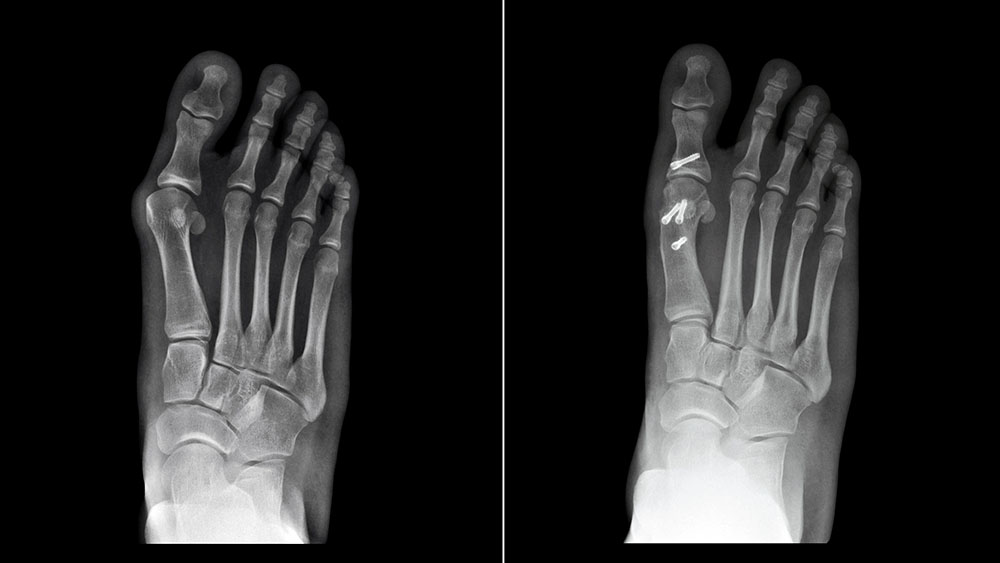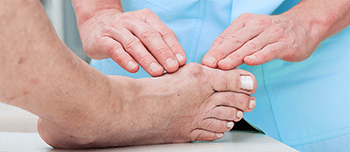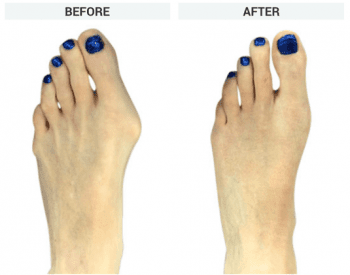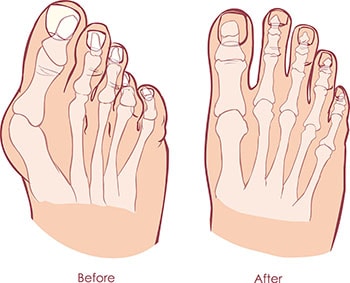
Absolutely! With over 50 types of Bunion Surgeries, it should be no surprise to anyone that most have not stood the test of time.
Why? Because new technological advances touch our lives almost every day. Thanks to modern research and development (R&D), medicine has seen amazing advances, including in bunion treatments.
Unfortunately, just because many conventional bunion surgeries no longer offer the best outcomes doesn’t mean they’re no longer performed. This happens for several reasons, including some surgeons simply not being comfortable learning advanced surgical techniques and adopting new technologies.
Please note: we generally only recommend bunion correction surgery if conservative treatment options have failed. Learn more about non-surgical bunion treatment options here.
7 Bunion Surgeries that have outlived their usefulness
In the interest of educating the general public, here’s a summary of some of the more well-known deprecated bunion surgeries. We’ve also included our thoughts on why these approaches are generally no longer used.
1) Shaft Osteotomies
This is a procedure that all podiatrists learn in medical school and involves making a bone cut (osteotomy) along the mid-shaft of the metatarsal (the long bone leading to the base of the big toe) to shift its position and thus correct its angle. Two screws are then inserted to hold the two metatarsal halves in position while the cut bone heals.
One osteotomy technique, known as the Z-bunionectomy, has been discarded as an effective procedure at the University Foot and Ankle Institute and the Bunion Institute. It has higher potential for misalignment and failure due to inadequate hardware support.
2) Scarf Osteotomy
The Scarf osteotomy involves making a Z-shaped cut along the shaft of the first metatarsal, splitting the mid-shaft of the bone in half along its vertical axis–kind of like slicing open a baguette. Next, the upper half of the metatarsal is rotated inward (toward the little toe) to line up the first metatarsal head with the base of the big toe. Two screws are used to hold the two halves of the metatarsal in their new position. Any bone protruding from the bottom part of the “baguette” is trimmed off.
The Scarf bunion surgery, while very effective at achieving a stable correction, is technically challenging. So, if it’s not performed by a surgeon with lots of experience in this technique, the Scarf is riskier than other procedures offering equivalent outcomes.
Although our surgeons have not totally stopped performing the Scarf osteotomy, it is only used for very large bunions in those patients who can’t comply with post-op non-weight-bearing restrictions.
3) The Traditional Tightrope Bunionectomy
In this procedure, a thin metal wire is wrapped around the first and second metatarsals and pulled tight in order to shift the first metatarsal into parallel alignment with the second metatarsal, thereby correcting its outward drift.
Unfortunately, this procedure has an unacceptably high rate of failure and increased risk of fracturing the second metatarsal. Tightrope Procedures are typically performed in patients with compromised bone quality due to vascular conditions, soft bones (osteoporosis), and smoking.
Today, our surgeons perform an improved variant of this procedure, but on a very limited patient population. Known as the Tightrope FT, this procedure begins just like the classic Tightrope: by threading a thin fiber-wire around the first and second metatarsals and tightening it – forcing the big toe to properly realign. The new twist is the removal of the first metatarsal head to decrease stress on that bone, provide added stability to its base, and accommodate soft tissue remodeling.
4) Closing Wedge Osteotomy
As its name suggests, “the wedge osteotomy” is an orthopedic surgical procedure that involves cutting a “pie wedge” from the side of the first metatarsal to force it into straight alignment.
As with the other obsolete procedures described here, there’s simply no reason to perform such an invasive procedure when better options with much better long-term outcomes exist.
In my opinion, the Wedge Bunionectomy was a cheating technique used in the old days to straighten out the joint at the base of the big toe to make it perpendicular to the first metatarsal, to create a straight line from the metatarsal shaft to the tip of the big toe.
The truth is, if you move the first metatarsal over properly and re-balance the supporting ligaments, there is no need to make a wedge cut in the metatarsal bone. In those isolated cases where the big toe itself has drifted out of alignment, we can perform an Akin osteotomy to re-align the toe so that it’s parallel to the second toe. Removing a wedge of bone from the first metatarsal jeopardizes the nerves and circulation and makes little sense.
5) McBride Bunionectomies
The McBride bunionectomy is rarely done these days, since it involves cutting the joint surface to change its slope. Since this approach avoids cutting and shifting the first metatarsal bone, it doesn’t bring it into correct alignment and so, fails to fully address the cause of the bunion.
6) Exostectomy
At UFAI, this is known as “the cheater’s attempt at bunion removal”. That’s because this procedure involves cutting the bony bump and nothing else. By not realigning the involved bones, an exostectomy doesn’t correct the bunion deformity. Even if it’s combined with another soft tissue procedure, an exostectomy almost never corrects the root cause of a bunion. Thus, it quickly comes back.
When performed today, exostectomy is just one part of a more comprehensive corrective surgery that includes a metatarsal osteotomy, plus soft-tissue procedures. If a foot surgeon recommends performing an exostectomy without a metatarsal osteotomy, don’t let them.
7) Resection Arthroplasty
In this procedure, your doctor removes the damaged portion of the big toe joint and pulls the first metatarsal and toe into correct alignment. Once part of the original joint is removed, scar tissue fills the gap, creating a flexible pseudo-joint. Resection arthroplasty is typically performed on select elderly patients, those who have had an unsuccessful bunion surgery, or persons with severe arthritis who want to avoid fusing the joint.
Because this procedure can change the “push off strength” of the big toe, which is vitally important for walking, it is rarely recommended.
What modern bunion procedures do we tend to do these days?
We’ve discussed some surgical approaches that have fallen out of favor; now, let’s briefly review some procedures that achieve great outcomes for our patients.
Always remember, there is no such thing as a “best bunion surgery.” This is because each patient is different, as is their foot anatomy, bunion deformity, bone quality, lifestyle, and work demands. Therefore, what may be perfect for one bunion patient, could be terribly wrong for another.
Please note: we generally only recommend bunion correction surgery if conservative treatment options have failed. Learn more about non-surgical bunion treatment options here.
MiniBunion™ Minimally Invasive Bunion Surgery
Our surgeons were intimately involved in developing the MiniBunion™ minimally invasive bunion procedure. The MiniBunion™ is designed to correct mild to moderate bunion deformities. 
The MiniBunion™ procedure is often called “the first minimally invasive bunion surgery that works.” That is because other surgeries that were called “minimally invasive” achieved only mixed results, at best.
Learn more about our miniBunion™ minimally invasive bunion surgery here.
Chevron Osteotomy Bunionectomy
For our active patients under the age of 50 with a mild to moderate bunion deformity, this procedure is one to consider. The Chevron has been the most commonly performed bunion surgery for almost two decades.
The specialists at University Foot and Ankle Institute and The Bunion Institute have taken this traditional osteotomy to the next level by incorporating improvements designed to create a sturdier, faster healing, and more cosmetically appealing correction. Our patients can bear weight immediately after surgery without the need for a cast.
Please note that many surgeons perform only this procedure since it has been around for so long. If you consult with a surgeon that only performs one type of bunion surgery, do yourself a big favor and talk to a different surgeon. Because no one bunion surgery is ever right for everyone!
Learn more about our modern Chevron Osteotomy Bunionectomy here.
Forever Lapidus Bunionectomy™
UFAI’s surgeons are the creators of the outpatient surgery known as the Forever Lapidus Bunionectomy™, which improves upon the traditional Lapidus procedure by adding protocols that dramatically improve healing, speed up recovery time, and virtually eliminate scarring.
Learn more about our Forever Lapidus Bunionectomy™ here.
Holistic metal-free bunion surgery
We also are one of the very first practices in the nation to offer “Holistic metal-free bunion surgery.” This is possible thanks to the use of Ossiofiber™ metal-free surgical hardware. Over time, the Ossiofiber product literally turns into bone, ending the need for patients to live with metal screws in their body or to removing hardware at a later date.
Our surgeons helped design the Ossiofiber technology and teach other surgeons how to utilize this innovative hardware.
Why choose University Foot and Ankle Institute for your bunion care?
If you are experiencing bunion pain, we’re always here to help. At UFAI, our mission is to provide the best bunion treatments available. We want our patients to be pain free and back to their daily activities as soon as possible.Our nationally recognized, board-certified Doctors of Podiatric Medicine (DPMs) offer the most advanced bunion care and the highest success rates in the nation. Our foot surgeons are leaders in developing surgical techniques and technologies that advance bunion treatment and improve patients’ experience everywhere. This is why many patients experiencing post-operative pain and unsatisfactory results from prior surgeries seek out our specialists for revision surgery.
We realize our patients lead busy lives, that’s why some of our podiatry clinics include their own MRIs, CAT scanners, and x-ray machines: to facilitate prompt diagnosis with minimal inconvenience. Plus, several of our clinics have in-house physical therapy facilities, giving our therapists immediate access to our doctors and our doctors the ability to closely monitor their patients’ progress.
For more information or to schedule a consultation, please call (877) 736-6001 or make an appointment online now.
At UFAI, we take our patients’ safety seriously. Our clinics’ and surgery centers’ Covid-19 patient safety procedures exceed all CDC recommendations. Masks are required in our institutes at all times.
We are conveniently located throughout Southern California and the Los Angeles area as our foot doctors are available at locations in or near: Santa Monica (on Wilshire Blvd.), Beverly Hills, West Los Angeles, Manhattan Beach, Northridge, Downtown Los Angeles, Westlake Village, Granada Hills, and Valencia, California.
- The Power of Pediatric Flexible Flatfoot Procedures - September 21, 2023
- StimRouter: A Revolutionary Approach to Targeted Pain Relief - August 21, 2023
- Is Cosmetic Foot Surgery Safe? Or Are You Starting Off on the Wrong Foot? - May 17, 2023
